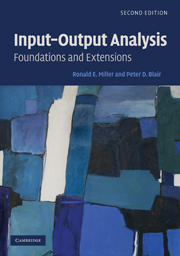Book contents
- Frontmatter
- Contents
- List of Figures
- List of Tables
- Preface
- 1 Introduction and Overview
- 2 Foundations of Input–Output Analysis
- 3 Input–Output Models at the Regional Level
- 4 Organization of Basic Data for Input–Output Models
- 5 The Commodity-by-Industry Approach in Input–Output Models
- 6 Multipliers in the Input–Output Model
- 7 Nonsurvey and Partial-Survey Methods: Fundamentals
- 8 Nonsurvey and Partial-Survey Methods: Extensions
- 9 Energy Input–Output Analysis
- 10 Environmental Input–Output Analysis
- 11 Social Accounting Matrices
- 12 Supply-Side Models, Linkages, and Important Coefficients
- 13 Structural Decomposition, Mixed and Dynamic Models
- 14 Additional Topics
- Appendix A Matrix Algebra for Input–Output Models
- Appendix B Reference Input–Output Tables for the United States (1919–2006)
- Appendix C Historical Notes on the Development of Leontief's Input–Output Analysis
- Author Index
- Subject Index
4 - Organization of Basic Data for Input–Output Models
Published online by Cambridge University Press: 05 June 2012
- Frontmatter
- Contents
- List of Figures
- List of Tables
- Preface
- 1 Introduction and Overview
- 2 Foundations of Input–Output Analysis
- 3 Input–Output Models at the Regional Level
- 4 Organization of Basic Data for Input–Output Models
- 5 The Commodity-by-Industry Approach in Input–Output Models
- 6 Multipliers in the Input–Output Model
- 7 Nonsurvey and Partial-Survey Methods: Fundamentals
- 8 Nonsurvey and Partial-Survey Methods: Extensions
- 9 Energy Input–Output Analysis
- 10 Environmental Input–Output Analysis
- 11 Social Accounting Matrices
- 12 Supply-Side Models, Linkages, and Important Coefficients
- 13 Structural Decomposition, Mixed and Dynamic Models
- 14 Additional Topics
- Appendix A Matrix Algebra for Input–Output Models
- Appendix B Reference Input–Output Tables for the United States (1919–2006)
- Appendix C Historical Notes on the Development of Leontief's Input–Output Analysis
- Author Index
- Subject Index
Summary
Introduction
Among the most formidable challenges in using input–output analysis in practice is assembling the detailed basic data needed to construct input–output tables characterizing the economic area of interest – national, regional, or perhaps multiple-regions. There are a variety of means by which these data are compiled, either for the specific area and time period of interest or adapted from other data sources.
In many cases, the data needed for construction of input–output tables are part of a larger collection of data assembled for a wide variety of socio-economic reasons. This is the case particularly in national economies where well-developed systems and standards for collecting economic data exist for such purposes as analyzing economic impacts of government policy that affects the economy, accountability for distribution of government revenues, or simply measuring the ongoing health of the economy. These basic data are often derived from social accounting data assembled in the form of a system of national (or regional) economic information1 which is often routinely collected by means of a periodic census or some other survey.
Observations on Ad Hoc Survey-Based Input–Output Tables
Sometimes data collected for an input–output table result from an ad hoc survey designed specifically for that purpose. This is especially common at the regional level, but has seldom led to such data collection becoming a routine part of the region's annual collection of socio-economic data for the region. The methods, conventions, and standards for carrying out ad hoc surveys designed specifically for constructing input–output tables vary widely depending upon circumstances.
- Type
- Chapter
- Information
- Input-Output AnalysisFoundations and Extensions, pp. 119 - 183Publisher: Cambridge University PressPrint publication year: 2009



